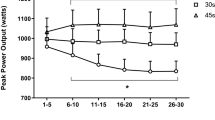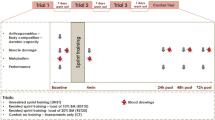Abstract
Purpose
The aims of this study were to evaluate the recovery kinetics of peak power output (PPO) following a maximal sprint, and to evaluate the influence of aerobic fitness on that recovery process.
Methods
On separate occasions, 16 well-trained men (age: 21 ± 3 years; height: 1.84 ± 0.05 m; and body mass: 78.8 ± 7.8 kg) performed a 30 s maximal sprint on a cycle ergometer, followed by a predetermined stationary rest period (5, 10, 20, 40, 80, and 160 s) and a subsequent 5 s sprint to determine PPO recovery kinetics. On another occasion, \({\dot V}{{\rm O}_{2}}\) was monitored during recovery from a 30 s sprint to provide a comparison with the recovery of PPO. Finally, subjects completed a \({\dot V}{{\rm O}_{2{\rm max}}}\) test to evaluate the influence of aerobic fitness on the recovery of PPO.
Results
Despite following similar time courses (F = 0.36, p = 0.558), and being well described by double-exponential models, the kinetic parameters of PPO and \({\dot V}{{\rm O}_{2}}\) in recovery were significantly different (p < 0.05). There was no significant relationship (r = 0.15; p = 0.578) between \({\dot V}{\rm O}_{2{\rm max}}\) and the time to achieve 50 % recovery of PPO. Moreover, there was no difference (p = 0.61) between the recovery kinetics of participants classified according to their \({\dot V}{\rm O}_{2{\rm max}}\) (59.4 ± 1.3 vs 48.5 ± 2.2 ml·kg−1·min−1).
Conclusion
Despite similar overall recovery kinetics, \({\dot V}{{\rm O}_{2}}\) and PPO show differences in key model parameters. Moreover, the recovery of PPO does not appear to be affected by aerobic fitness.




Similar content being viewed by others
Abbreviations
- ANOVA:
-
Analysis of variance
- GET:
-
Gas exchange threshold
- PCr:
-
Phosphocreatine
- PPO:
-
Peak power output
- \({\dot V}{{\rm O}_{2}}\) :
-
Rate of oxygen uptake
- \({\dot V}{\rm O}_{2{\rm max}}\) :
-
Maximal rate of oxygen uptake
References
Allen DG, Lamb GD, Westerblad H (2008) Skeletal muscle fatigue: Cellular Mechanisms. Physiol Rev 88:287–332
Ament W, Verkerke GJ (2009) Exercise and fatigue. Sports Med 39(5):389–422
Aziz AR, Chia M, Teh KC (2000) The relationship between maximal oxygen uptake and repeated sprint performance indices in field hockey and soccer players. J Sports Med Phys Fitness 40:195–200
Bahr R (1992) Excess postexercise oxygen consumption: magnitude, mechanisms and practical implications. Acta Physiol Scand 144(Suppl. 605):1–70
Baker AJ, Kostov KG, Miller RG, Weiner MW (1993) Slow force recovery after long-duration exercise: metabolic and activation factors in muscle fatigue. J Appl Physiol 74(5):2294–2300
Barker AR, Welsman JR, Fulford J, Welford D, Williams CA, Armstrong N (2008) Muscle phosphocreatine and pulmonary oxygen uptake kinetics in children at the onset and offset of moderate intensity exercise. Eur J Appl Physiol 102:727–738
Balsom PD, Ekblom B, Sjödin B (1994a) Enhanced oxygen availability during high intensity intermittent exercise decreases anaerobic metabolite concentrations in blood. Acta Physiol Scand 150:455–456
Balsom PD, Gaitanos GC, Ekblom B, Sjödin B (1994b) Reduced oxygen availability during high intensity intermittent exercise impairs performance. Acta Physiol Scand 152:279–285
Beaver WL, Wasserman K, Whipp BJ (1986) A new method for detecting anaerobic threshold by gas exchange. J Appl Physiol 60(6):2020–2027
Bishop D, Spencer M (2004) Determinants of repeated-sprint ability in well-trained team-sport athletes and endurance-trained athletes. J Sports Med Phys Fitness 44:1–7
Bogdanis GC, Nevill ME, Boobis LH, Lakomy HK, Nevill AM (1995) Recovery of power output and muscle metabolites following 30 s of maximal sprint cycling in man. J Physiol 482:467–480
Børsheim E, Bahr R (2003) Effect of exercise intensity, duration and mode on post-exercise oxygen consumption. Sports Med 33:1037–1060
Cherry PW, Lakomy HK, Boobis LH, Nevill ME (1998) Rapid recovery of power output in females. Acta Physiol Scand 164:79–87
Dodd S, Powers SK, Callender T, Brooks E (1984) Blood lactate disappearance at various intensities of recovery exercise. J Appl Physiol Respir Environ Exerc Physiol 57(5):1462–1465
Dupont G, McCall A, Prieur F, Millet GP, Berthoin S (2010) Faster oxygen uptake kinetics during recovery is related to better repeated sprinting ability. Eur J Appl Physiol 110:627–634
Durnin JV, Womersley J (1974) Body fat assessed from total body density and its estimation from skinfold thickness: measurements on 481 men and women aged from 16 to 72 years. Br J Nutr 32:77–97
Edge J, Bishop D, Goodman C, Dawson B (2005) Effects of high- and moderate-intensity training on metabolism and repeated sprints. Med Sci Sports Exerc 37:1975–1982
Forbes SC, Slade JM, Meyer RA (2008) Short-term high-intensity interval training improves phosphocreatine recovery kinetics following moderate-intensity exercise in humans. Appl Physiol Nutr Metab 33:1124–1131
Fukuoka Y, Grassi B, Conti M, Guiducci D, Sutti M, Marconi C, Cerretelli P (2002) Early effects of exercise training on on- and off-kinetics in 50-year-old subjects. Pflugers Arch 443:690–697
Fukuoka Y, Nakanishi R, Ueoka H, Kitano A, Takeshita K, Itoh M (2006) Effects of wheelchair training on \({\dot V}{{\rm O}_{2}}\) kinetics in the participants with spinal-cord injury. Disabil Rehabil Assist Technol 1:167–174
Gandevia SC (2001) Spinal and supraspinal factors in human muscle fatigue. Physiol Rev 81(4):1725–1789
Glaister M (2008) Multiple-sprint work: methodological, physiological, and experimental issues. Int J Sports Physiol Perform 3:107–112
Glaister M, Stone MH, Stewart AM, Hughes MG, Moir GL (2007) The influence of endurance training on multiple sprint cycling performance. J Strength Cond Res 21:606–612
Glaister M, Witmer C, Clarke DW, Guers JJ, Heller JL, Moir GL (2010) Familiarisation, reliability, and evaluation of a multiple sprint running test using self-selected recovery periods. J Strength Cond Res 24(12):3296–3301
Hamilton AL, Nevill ME, Brooks S, Williams C (1991) Physiological responses to maximal intermittent exercise: differences between endurance-trained runners and games players. J Sports Sci 9:371–382
Haseler LJ, Hogan MC, Richardson RS (1999) Skeletal muscle phosphocreatine recovery in exercise-trained humans is dependent on O2 availability. J Appl Physiol 86(6):2013–2018
Krustrup P, Jones AM, Wilkerson DP, Calbet JAL, Bangsbo J (2009) Muscle and pulmonary O2 kinetics during moderate- and high-intensity sub-maximal knee-extensor exercise in humans. J Physiol 587:1843–1856
Marwood S, Roche D, Garrard M, Unnithan VB (2011) Pulmonary oxygen uptake and muscle deoxygenation kinetics during recovery in trained and untrained male adolescents. Eur J Appl Physiol 111:2775–2784
McCully KK, Fielding RA, Evans WJ, Leigh JS Jr, Posner JD (1993) Relationships between in vivo and in vitro measurements of metabolism in young and old human calf muscles. J Appl Physiol 75:813–819
Özyener F, Rossiter HB, Ward SA, Whipp BJ (2001) Influence of exercise intensity on the on- and off-transient kinetics of pulmonary oxygen uptake in humans. J Physiol 533(3):891–902
Paganini AT, Foley JM, Meyer RA (1997) Linear dependence of muscle phosphocreatine kinetics on oxidative capacity. Am J Physiol 272:C501–C510
Rossiter HB, Ward SA, Kowalchuk JM, Howe FA, Griffiths JR, Whipp BJ (2002) Dynamic asymmetry of phosphocreatine concentration and O2 uptake between the on- and off-transients of moderate- and high-intensity exercise in humans. J Physiol 541:991–1002
Takahashi H, Inaki M, Fujimoto K, Katsuta S, Anno I, Niitsu M, Itai Y (1995) Control of the rate of phosphocreatine resynthesis after exercise in trained and untrained human quadriceps muscles. Eur J Appl Physiol Occup Physiol 71:396–404
Tomlin DL, Wenger HA (2001) The relationship between aerobic fitness and recovery from high intensity intermittent exercise. Sports Med 31(1):1–11
Yoshida T (2002) The rate of phosphocreatine hydrolysis and resynthesis in exercising muscle in humans using 31P-MRS. J Physiol Anthropol Appl Human Sci 21:247–255
Yoshida T, Watari H (1997) Effect of circulatory occlusion on human muscle metabolism during exercise and recovery. Eur J Appl Physiol Occup Physiol 75:200–205
Acknowledgments
The authors would like to express their gratitude to all the subjects for their enthusiasm and commitment to the project.
Conflict of Interest
The authors have no conflicts of interest that are relevant to the content of this article.
Author information
Authors and Affiliations
Corresponding author
Additional information
Communicated by Keith Phillip George.
Rights and permissions
About this article
Cite this article
Glaister, M., Pattison, J.R., Dancy, B. et al. The influence of aerobic fitness on the recovery of peak power output. Eur J Appl Physiol 114, 2447–2454 (2014). https://doi.org/10.1007/s00421-014-2968-9
Received:
Accepted:
Published:
Issue Date:
DOI: https://doi.org/10.1007/s00421-014-2968-9




